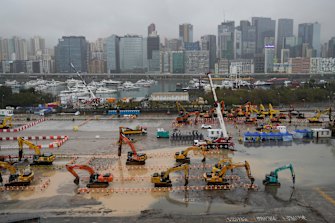

The “zero-COVID-19” strategy means that Hong Kong authorities often take measures such as locking down residential estates for mass testing when positive cases are detected, imposing strict quarantine requirements on travellers and ordering the shuttering of businesses.
The rapid surge of infections in the city has threatened to overwhelm its healthcare system.

A construction site where facilities for isolating COVID-19 patients are built in Kai Tak Cruise Terminal.Credit:AP
Health officials said last week that hospitals were already at 90 per cent of capacity and isolation facilities were full. People who test positive for the virus in Hong Kong must either be admitted to a hospital or a quarantine facility.
Lam acknowledged on Tuesday that the city’s isolation facilities are “severely inadequate” and that it is “working very hard with the full support of the central authorities” to build more.
Current social-distancing measures, such as a ban on dining at restaurants after 6 p.m. and the closure of businesses such as gyms and bars, will be extended until April 20.
“This is not good news to the sectors affected, but really at this stage of the pandemic we have no choice but to take these measures,” Lam said.
She said the city hopes to boost its vaccination rate to 90 per cent by early March.
Other measures announced Tuesday include ending the school year early and moving the normal July-August summer holidays forward to March and April so that schools can be turned into facilities for testing, isolation and vaccination.
Flight bans from countries classified as high risk, including Australia, Canada, India, Nepal, Pakistan, the Philippines, Britain and the US, will be extended to April 20.



























